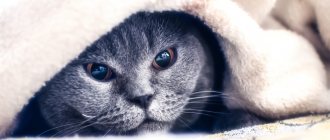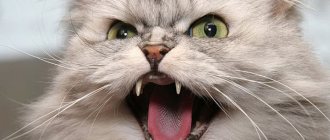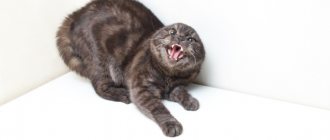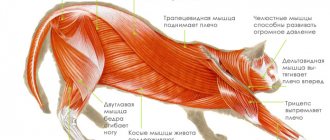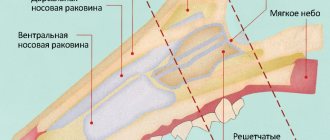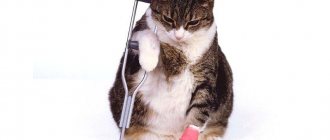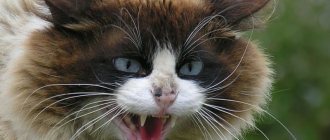Flatulence occurring in cats is a common phenomenon, which is an excessive accumulation of gases in the intestines. Often this condition is accompanied by rumbling in the stomach, hiccups, alternating constipation and diarrhea. A number of factors can provoke the problem, some of which are dangerous. Therefore, if bloating is detected, the animal should be taken to a veterinary clinic.
Causes of the condition
Non-pathological factors
Cats can pass gas not only because of health problems; there are also harmless reasons, for example, an incorrect diet. It is not recommended to give adult animals milk, bread, or fatty foods. In addition, the fish that owners are accustomed to feeding their pets is poorly absorbed by their bodies, so it is given in limited quantities. You should not feed cats sweets, sausages or smoked meats.
Under normal conditions, when eating food, the animal swallows a small amount of air, but it is so minimal that it does not affect digestion. However, sometimes cats take large gulps of air, which is called aerophagia in veterinary medicine. It is observed when a cat eats too large pieces of food, salty foods, or foods that have an excessively high or low temperature. This condition does not require treatment. Owners only need to give their cat small pieces of food at room temperature.
Pathological factors
Flatulence can also be due to the following reasons:
This condition is typical for animals that have parasites.
- Worm infestation. When a pet is infected with worms, rumbling in the stomach, attacks of nausea and vomiting, and diarrhea are observed. Cats pass gas and their tummy is swollen. If the owners do not notice the problem in time, helminthic infection sometimes leads to death, since serious intoxication of the body is observed.
- Peritonitis. It is considered one of the most life-threatening factors for a cat when flatulence occurs. Pathology can be triggered by a number of factors, including coronavirus, which cannot be treated and leads to death.
- Ascites. During this disease, a large amount of fluid accumulates in the abdominal cavity, which causes flatulence. The kitten's stomach growls strongly, while the appetite decreases, and the animal becomes weak.
- Neoplasms. Flatulence is sometimes triggered by the presence of malignant and benign tumors in the peritoneal area. Owners in such a situation may notice that the pet develops diarrhea, exhaustion, and vomiting.
- Constipation. It can be caused by various factors, but is often associated with an improper diet or the presence of worms in the body. At the same time, not only feces, but also gases do not pass through the intestines.
- Plague. The disease is caused by parvovirus. In addition to flatulence, animals experience increased body temperature, diarrhea, vomiting, and loss of appetite. The disease is mainly diagnosed in kittens.
Causes of gas in cats
There are many reasons why your cat has too much gas. Common reasons are listed below:
- Infection in the intestines (both bacterial and viral)
- Intestinal parasites (eg, roundworms, hookworms)
- Overeating or eating too quickly (swallowing too much air)
- Eating spoiled food
- Inflammatory bowel disease (IBD)
- Malabsorption (the body has difficulty absorbing nutrients)
- Digestive disorders (difficulty digesting food)
- Intolerance/allergy (eg milk)
- Diet (eg high in fiber or soy)
- Constipation
How does it manifest?
If an animal is bothered by the accumulation of gases, it may meow pitifully.
Doctors note that the following symptoms are typical for flatulence:
- restless cat behavior;
- plaintive meow;
- vomit;
- constipation or diarrhea;
- rumbling in the stomach;
- muscle spasms;
- bloating;
- loss of appetite;
- thirst.
Why do cold sores appear on the lips?
Those who suffer from herpes have noticed that exacerbations begin along with ARVI. Herpes occurs when immunity decreases, the protective forces of which are used to suppress ARVI. Colds on the lips also appear when the body’s defenses are weakened: with chronic fatigue, lack of sleep, frequent stress, poor diet, alcohol abuse and active smoking, in women at the beginning of pregnancy and in the first 5-7 days after childbirth.
Photo: Colds on the lips can only appear if the immune system is weakened
Diagnostics
If a cat passes gas for several days, this should alert the owners. In such a situation, you should contact a veterinary clinic. At the appointment, the doctor will conduct a survey of the owners, during which he will find out how long ago the unwanted symptoms arose. Then the veterinarian begins to examine and feel the pet’s abdomen. To confirm the preliminary diagnosis, the cat is sent for the following examinations:
- general and biochemical blood tests;
- stool analysis;
- radiography;
- ultrasonography.
Diagnosis and treatment of causes of bloating
An accurate diagnosis must be made by a veterinarian in the clinic. The study requires a general analysis of blood, urine and feces. A general clinical physical examination of the patient is carried out using palpation and auscultation methods.
It is especially important to study the animal’s feces, which makes it possible to confirm or refute the presence of helminths in the intestinal tract. It is necessary to conduct a stool analysis to determine the presence of tumor processes
Accurate diagnosis involves ultrasound examinations of the abdominal organs and radiography, which allows you to get a real picture of what is happening. Treatment of flatulence is based on the established diagnosis and includes some basic points:
- antispasmodics No-shpa and Traumeel (relieving spasms and pain);
- enterosorbents (activated carbon, Polysorb, Smecta);
- probiotics (reducing the risk of formation of putrefactive microflora and restoring the intestines after a course of antibiotics);
- hepatoprotectors (protect liver structures and help normalize protein metabolism).
Diagnosed ascites or peritonitis require immediate surgical intervention. After the surgical procedure, the animal must remain under the supervision of specialists in the hospital for some time. If necessary, the outflow of fluid is regulated by introducing a drainage system. Monitoring the pet’s condition and regulating all vital processes of the patient’s body is important. Antibiotic therapy, anti-inflammatory drugs and some specific medications are prescribed.
If your cat’s stomach bloats periodically after eating, you need to carefully review the diet and choose a more balanced one. Eliminate flour and sweet, dairy and fermented milk products from your diet. A veterinarian should advise medications containing enzymes to improve digestion (if there is such a need and flatulence is associated with enzyme deficiency).
How is the treatment carried out?
It is necessary to prevent the animal from accessing the trash can.
First of all, veterinarian Tatyana Sergeevna Semirotova recommends normalizing the pet’s diet. Foods that contain large amounts of carbohydrates should be removed from the menu. In addition, it is important for cat owners to prevent the cat from greedily and abundantly absorbing food. The daily intake should be divided into small portions. The temperature of the finished dish should not exceed 25 degrees Celsius. It is important that the animal should not be given spoiled food. If your cat likes to rummage through the trash can, you need to move it out of reach.
When your pet is on complementary food, which is sold in stores, attention should be paid to ensure that it does not contain a lot of fiber, since it provokes flatulence.
The cat may also be prescribed medications. Sorbents are often used, for example, Polysorb and Enterosgel. Therapy for flatulence may also involve the use of probiotics. One of the most effective is a medicine called “Baikal”. In combination with the use of medications, doctors recommend monitoring the animal’s activity. You should take your cat for walks more often, but if this is not possible, active leisure can be organized at home by purchasing a sufficient number of toys for your pet. Physical activity will reduce the risk of gastrointestinal pathologies, including flatulence.
Foods that cause flatulence
Scientists have proven and repeatedly confirmed the role of nutrition in the occurrence of flatulence2,3.
Products that increase gas formation2,3:
- legumes,
- cabbage,
- spinach,
- sorrel,
- onion and garlic,
- radishes and turnips,
- carrot,
- celery,
- dates,
- bananas,
- apples,
- gooseberry,
- raspberries,
- kvass and beer,
- black bread,
- raisin,
- prunes,
- whole milk,
- carbonated drinks,
- caffeinated drinks,
- alcohol1,3.
Products containing carbohydrates are recognized as dangerous from the point of view of increased gas formation: oligosaccharides, disaccharides, monosaccharides and polyols7. All these carbohydrates are united by the term “FODMAP”, meaning Fermentable Oligo-, Di-, Mono- and Polyol. They are poorly absorbed in the intestine; remaining in it, they become food for bacteria and provoke the development of flatulence with all its inherent symptoms3,7.
FODMAP - foods containing “dangerous” carbohydrates
| Oligosaccharides (fructans and galactans) | vegetables: beets, white cabbage and Brussels sprouts, broccoli and garlic, onions, leeks and shallots, artichokes and asparagus, dill and okra (okra) |
| beans (including green beans), chickpeas, lentils and peas | |
| fruits: apples, watermelons, white peaches, persimmons, rambutan | |
| all cereals made from rye and wheat, as well as products made from them | |
| Disaccharides (lactose) | regular and low-fat cow's milk, goat's milk |
| ice cream made from whole milk and cream | |
| regular and low-fat yogurts | |
| soft cheeses: mozzarella, suluguni, Adyghe, fat cream cheeses | |
| Monosaccharides (fructose) | apples, pears, peaches, watermelon and mangoes, especially in large quantities |
| juices and concentrated sauces from the listed fruits | |
| dried fruits and canned fruits | |
| honey and products containing it | |
| Polyols (sugar alcohols) | fruits: watermelons, apples, pears, plums, prunes, apricots, peaches, nectarines, cherries, avocados, lychees |
| vegetables: all types of cabbage and green peas | |
| mushrooms | |
| sweeteners: isomaltitol, maltitol, mannitol, sorbitol, xylitol, as well as sweeteners ending in “-ol”, such as erythritol |
Up to contents
Prevention
To avoid causing bloating, pet owners need to normalize their diet. You should consult a doctor who will tell you what kind of food leads to flatulence in a particular animal. You need to protect your cat from greedily eating food. It is better to have meals at the same time every day. The menu should limit large amounts of fiber and carbohydrates. In addition, you can train your cat to drink an infusion of medicinal herbs. It is recommended to use chamomile, mint or dill. These remedies reduce the risk of digestive problems.
Main predisposing factors
Aerophagia (“eating” air) is a phenomenon observed during greedy, hasty eating of food. In this case, the animal swallows large volumes of atmospheric air, which accumulates in its digestive system. Diets that contain inappropriately large amounts of soy and other legumes also contribute to bloating. It must be remembered that cats, unlike dogs, are much more sensitive to low-quality products - feeding spoiled food will lead to food poisoning and serious bloating.

